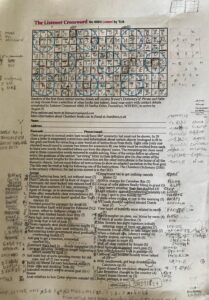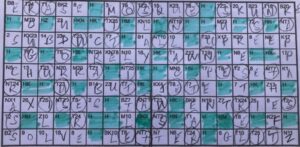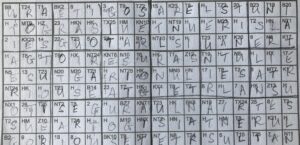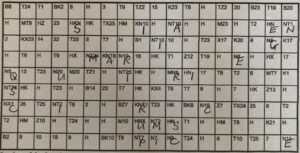7Hold on to your seats, this puzzle (by ‘eck) is quite a ride.
The grids displayed on blogs like these are often Pristine Productions. Here’s the gory truth about what solving this amazing puzzle looked like, and that’s before three further grids were used as well (see below):
 We’re not sure we could read those notes either by the end, but fortunately the submission grid was a simple one so any slips were hopefully buried. But we are getting ahead of ourselves. The preamble was long, detailed, and only going to really make sense as the solving progressed, so we cracked on with the clues. A little more prep at this point, like setting up a spreadsheet to keep track of how the lettered cells were performing, especially the Ns, might have helped…
We’re not sure we could read those notes either by the end, but fortunately the submission grid was a simple one so any slips were hopefully buried. But we are getting ahead of ourselves. The preamble was long, detailed, and only going to really make sense as the solving progressed, so we cracked on with the clues. A little more prep at this point, like setting up a spreadsheet to keep track of how the lettered cells were performing, especially the Ns, might have helped…
There’s too much else to report on to say much about the clues, except that they were a good set but no pushover. After a bit of cold solving we started to map out where they and the unwanted bars might go, and when we finally cracked the first two acrosses the grid started to fill nicely. Getting the double entries into the right squares tripped us up a bit, but eventually the job was done.
Now for the first message from the clue misprints, which turned out to be
NINE LETTER ONES ROUND MUS CHI STARTS ZETA ENDS so we were needing a letter variety of the “certain objects” that we were to find in the grid and they should centre on MUs and have something beginning on CHIs and ending on ZETAs – with the Greek letters presumaby being the Ms Xs and Zs in the grid. Circles were drawn and each helpfully incuded one X and one Z. But what were they?
We were told that the non-retained letters from the clashes would anagram to give us the answer, which turned out to be POLYGON. And …? At this point the extra words from clues which defined the diminished form of the overlong answers, and so showed what the surplus letters were, came into play again because once they were matched up, the one surplus letter phrase was “Saturday Review” (aka “here” aka “Hear!” aka “Listen!).
DEARNLY DEARLY fondLy
BUSHELS BUSHES ciStaceae maybe
HOARED HARED went postHaste
LION LIN chIne
COWPING COWING broWbeating
SUTILE UTILE of Use
BIFFING BIFFIN rufesceNt fruit
GYRATE GRATE caGe
SELLS SELS egoS in Caledonia
Now our focus in that august production is the Listener, but there too stands the popular Polygon puzzle, and the place of the retained letter in the definition word or phrase was therefore indexing the length of the word to be formed from the relevant Polygon.
The words beginning with Beta gave us a message this time:
ERASE ALL BUT TAU ENTRIES SOLVE LETTER SUDOKUS USE KAPPA
Time for another new grid and yet another sort of puzzle. (Could we have a multi-puzzle tournament a bit like the Triathlon? I expect there already is one and ‘Eck has probably won it.)
It’s Ks this time and it was becoming obvious that they weren’t going to provide the quotation that would finish the game but another message: ERASE ENTER ORIGINAL NUS



It’s NINE-LETTER ONES… (as I see you had in your grid). And they are all anagrams of 9-letter words. What a slog that was! My schoolboy Latin suggested AENIGMAM, but it’s actually 3rd-declension neuter.
Absolutely. Typing monster struck again. Blog corrected. Thanks.
A clever final message to stymie short-cut attempts — if it occurred to solvers to see if any particular Greek letter spelt out a coherent message in the original grid, they would see S..I..A..E..N.. and give up!
Gave up with this after quite simply finding no way in despite cold solving many clues. If you don’t mind me saying so, stating that ‘after a bit of cold solving we started to map out where [the entries] and…bars might go’, without actually explaining how or why you worked it out is not especially enlightening for those of us at the back of the class who failed in that initial – and evidently crucial – step. Can you explain the reasoning?
I took the reference to the title to be “List n” – suggesting that the codeword could be solved by frequency analysis. Of course, that could also have referred to the very final step, in which case there was a relatively quick short cut available. However, the cold solving involved to get to the point of starting to fill the first grid was certainly not trivial even in itself.